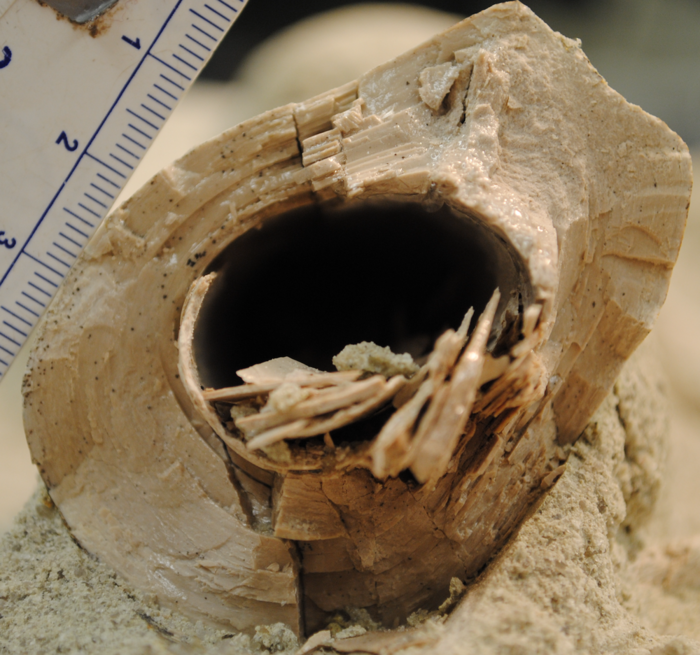The meat-eating dinosaurs known as theropods that roamed the ancient Earth ranged in size from the bus-sized T. rex to the smaller, dog-sized Velociraptor. Scientists puzzling over how such wildly different dinosaur sizes evolved recently found – to their surprise– that smaller and larger theropod dinosaurs like these didn’t necessarily get that way merely by growing slower or faster.

Credit: Michael D. D’Emic
The meat-eating dinosaurs known as theropods that roamed the ancient Earth ranged in size from the bus-sized T. rex to the smaller, dog-sized Velociraptor. Scientists puzzling over how such wildly different dinosaur sizes evolved recently found – to their surprise– that smaller and larger theropod dinosaurs like these didn’t necessarily get that way merely by growing slower or faster.
In a new paper published in Science, “Developmental strategies underlying gigantism and miniaturization in non-avialan theropod dinosaurs,” researchers including Ohio University professor Patrick O’Connor and Ph.D. student Riley Sombathy discovered through examining the bones of dinosaurs that there was no relationship between growth rate and body size.
“Most animals are thought to evolve to be larger by growing faster than their ancestors, but this study shows that it’s just as likely that bigger and smaller animals grew for longer or shorter periods of time during growth spurts,” said Michael D. D’Emic, a paleontologist at Adelphi University and lead author of the study.
The bones of many animals, including dinosaurs, slowed or paused growth every year, leaving marks like tree rings that indicate the animal’s age and can be used to estimate the rate of growth. “Rings like these are called cortical growth marks,” said D’Emic. “Widely spaced rings indicate faster growth and narrowly spaced rings tell us that an animal was growing more slowly.”
D’Emic, O’Connor, Sombathy and a team of international researchers measured about 500 such growth rings in about 80 different theropod bones, the two-legged, mostly meat-eating species of dinosaurs closely related to birds.
“We found that there was no relationship between growth rate and size,” said D’Emic. “Some gigantic dinosaurs grew very slowly, slower than alligators do today. And some smaller dinosaurs grew very fast, as fast as mammals that are alive today.” This made sense to co-author Thomas Pascucci, whose graduate thesis contributed to the project: “Extinct animals like dinosaurs inspire awe because of how different they seem from our modern world, but they were animals that grew under similar constraints and environmental factors as those that exist today.”
According to O’Connor, this study opens the door to future investigations of how animals regulate their growth. “Alteration of different growth control mechanisms, at molecular or genetic levels, likely accounts for the range of developmental strategies our team observed in theropod dinosaurs. Future studies of living organisms provide an opportunity to elucidate mechanisms related to the evolution of body size in vertebrates more generally.”
Sombathy hopes to take up some of those investigations, adding “One of the things that interests me most about the results is the apparent decoupling between growth rate and body size. My Ph.D. dissertation will investigate the impacts of growth rate and body size on bone shape and function.”
“This has really important implications because changes in rate versus timing can correlate to many other things, like how many or how large your offspring are, how long you live, or how susceptible to predators you are,” D’Emic added. “Hopefully this research spurs investigations into other groups, both alive and extinct, to see what developmental mechanisms are most important in other types of animals.”
In addition to O’Connor, Sombathy, and D’Emic, the paper was co-authroed by Ignacio Cerda of Consejo Nacional de Investigaciones Científicas y Técnicas (CONICET) and Universidad Nacional de Río Negro in Argentina, David Varricchio of Montana State University; Diego Pol of CONICET-Museo Paleontológico Egidio Feruglio in Argentina, Rodolfo Coria of Museo Carmen Funes in Argentina; and Kristina A. Curry Rogers of Macalester College in Minnesota. The study was funded, in part, by the US National Science Foundation and Adelphi University.
Journal
Science
DOI
10.1126/science.adc8714
Method of Research
Computational simulation/modeling
Subject of Research
Animals
Article Title
Developmental strategies underlying gigantism and miniaturization in non-avialan theropod dinosaurs
Article Publication Date
24-Feb-2023




